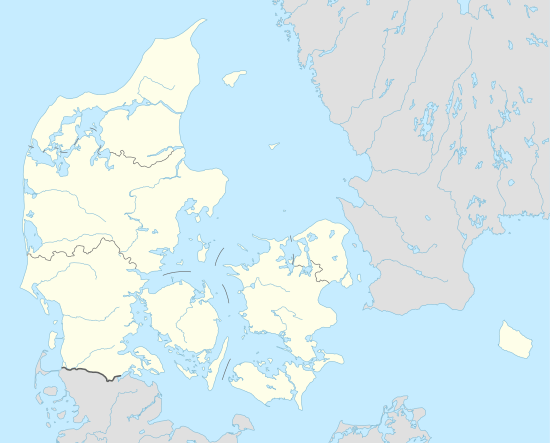Billund, Denmark
Billund (Danish pronunciation: [ˈpiˌlɔnˀ]) is a town in Jutland, Denmark. It is the home of the Lego Group head office. A company town, it is also the site of a theme park, Legoland, waterpark resort, Lalandia, and Billund Airport which is the second largest airport in Denmark. The airport opened in 1964 and was built by the Lego Group, but is now run independently.[1] With a population of 6,662 (1st January 2020),[2] Billund is the second largest town in Billund Municipality, Region of Southern Denmark, following the municipal seat of Grindsted.
Billund | |
|---|---|
Town | |
.jpg) Billund Kro | |
 Billund Location within Denmark | |
| Coordinates: 55°43′51″N 9°6′55″E | |
| Country | Denmark |
| Region | Southern Denmark |
| Founded | 17th century |
| Area | |
| • Urban | 8.21 km2 (3.17 sq mi) |
| Population (2020) | |
| • Urban | 6,662 |
| • Urban density | 810/km2 (2,100/sq mi) |
| Time zone | GMT +1 |
| Postal code | 7190 Billund |
| Website | billund-grindsted.dk |
On the outskirts of the town there is a Lego factory, which, as of 2005, manufactured 90% of the company's products. Adjacent to the company's headquarters is the first Legoland theme park, which opened in 1968 and is called Legoland Billund.[1] In addition to the Lego Group, Sun-Air of Scandinavia has its head office in Billund.[3][4]
History
Billund has long been part of the parish of Grene Kirke ("Grove Church") whose original Romanesque building was first mentioned in 1291. The town's name was first mentioned as "Byllundt" in 1454 and as "Billund" in 1510.
In 1880, the town's first windmill was built on the road between Vejle and Varde. In 1895, the mill burned to the ground but was rebuilt in 1897, this time in the style of Dutch windmills. That same year, a railway was built from Vejle to Billund, and the route was later extended to Grindsted in 1914.
In 1916, Ole Kirk Christiansen, who later founded The Lego Group, bought a Billund furniture company that was founded in 1895. He invested in the town, creating a new dairy and the Skjoldbjerg church a few miles south of town. In 1930, Kirk Christiansen began producing utility items such as ironing boards, stepladders and miniature toys. His first toys were created from scraps from the production of his other goods but his true toy production started in 1932. In 1934, the toy factory was named "Lego."
In the late 1930s Billund experienced growth due to the factories and began to build waterworks, a gymnasium, and the town hall, though the local power station was closed and relocated.
In 1942, during the Nazi occupation in World War II, the old Lego factory was destroyed by fire, but a new one was immediately erected. In 1946, the railway track from Grindsted was extended to the Lego factory. Plastic Lego Bricks were first released from the factory in 1949.
The 1950s brought a recession to Billund with the closing of the railroad. In response to the growing poverty, the Billund Housing Association was founded and created affordable housing as well as a retirement home. Lego created a large park north of town with a playground, outdoor scene, toboggan hill and a man-made lake in 1959. In 1964 the Billund Airport was inaugurated, first as the Lego Group's private airport, and was later opened for other uses. Legoland opened in 1968, and Billund again began to experience growth.
Geography
Billund is located approximately 13 kilometers (8 miles) from Grindsted, 56 kilometers (35 miles) from Esbjerg, and 27 kilometers (17 miles) from The Regional Capital of Vejle.
Demographics
As of 2012 the town had 6,146 residents. In the beginning of the 1930s Billund was still a small village with only 300 residents. In the 1950s the village reached 500 residents and after this time that number increased rapidly. After only 20 years, in 1970 this number quadrupled to 2,065 residents. Population growth exploded because of Lego's rapid expansion in the mid-1960s.
The town's demographics are characterized by many families with children; approximately 27.3% of the households in the town consist of couples with children. This is somewhat above the average for the region. The residents in the town mostly live in family houses.
Notable people
- Godtfred Kirk Christiansen (1920 in Billund – 1995) the managing director of The Lego Group from 1957 to 1979
- Kjeld Kirk Kristiansen (born 1947 in Billund) the former president and CEO of The Lego Group (1979–2004) and the third richest Dane, with a net worth of $4.7 billion as of February 2020.[5][6]
- Line Bonde (born c.1979) a Danish fighter pilot, brought up in Billund. In July 2006, aged 27, she became the first female Danish fighter pilot, flying an F-16 jet fighter
Tourism
The presence of the Lego factory draws tourists to Billund. A new 23-metre tall Lego House opened in late 2017. Other attractions include Givskud Zoo, Kongernes Jelling, the Vandel Museum and the Children's Library designed by Rosan Bosch.[7] Billund railway line is currently under construction to serve the town and its airport.
References
- "Billund, Denmark". TripWiser.com.
- BY3: Population 1 January, by urban areas The Mobile Statbank from Statistics Denmark
- "Locations Archived 9 March 2010 at the Wayback Machine." Lego Group. Retrieved on 16 March 2010.
- "Contact Archived 20 August 2010 at the Wayback Machine." Sun Air of Scandinavia. Retrieved on 16 March 2010.
- The World's Billionaires - Denmark. Forbes.com. Last looked at on February 14th, 2020.
- "Meet The Richest Billionaire In Every Country". Forbes. Retrieved 15 December 2015.
- "Children's Library in Billund - Finalist". Danish Design Award.